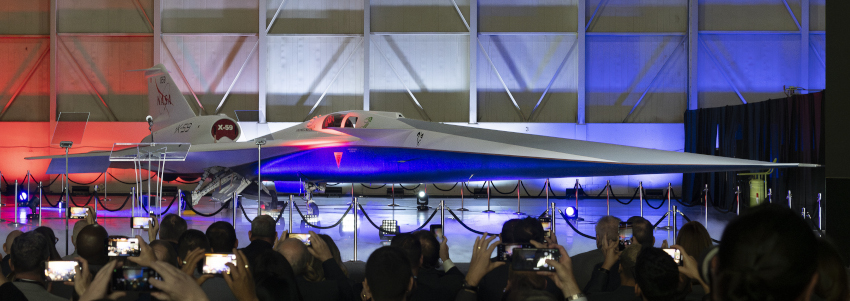
NASA, Lockheed unveil X-59 quiet supersonic aircraft
By DE Staff
General AerospaceExperimental aircraft designed to reach speeds up to 925 mph while producing quieter sonic boom.

NASA and Lockheed Martin’s X-59 quiet supersonic research aircraft at its unveiling ceremony in Lockheed Martin’s Skunk Works facility in Palmdale, California.
(Image Credit: NASA/Steve Freeman)
NASA and Lockheed Martin recently debuted the agency’s X-59 quiet supersonic aircraft at Lockheed Martin’s Skunk Works in Palmdale, California. The partners say their aim is to usher in a new generation of supersonic commercial aircraft.
The X-59 is at the center of NASA’s Quesst mission, which focuses on providing data to help regulators reconsider rules that prohibit commercial supersonic flight over land. Supersonic jets have been considered too loud for over land flight for 50 years, However, the X-59 is designed to reach upwards of 925 mph while producing a quieter flight.
According to NASA, the aircraft’s shape and the technological advancements will make that possible. At 99.7 feet long and 29.5 feet wide, the X-59’s tapered nose accounts for almost a third of its length and will break up the shock waves that would ordinarily result in a supersonic aircraft causing a sonic boom.
Due to this configuration, the cockpit is located almost halfway down the length of the aircraft – and does not have a forward-facing window. Instead, the Quesst team developed the eXternal Vision System, a series of high-resolution cameras feeding a 4K monitor in the cockpit. The aircraft also features a top-mounted engine and a smooth underside to help keep shockwaves from merging behind the aircraft and causing a sonic boom.
The Quesst team says the next step will be to conduct several of the aircraft’s flight tests at Skunk Works before transferring it to NASA’s Armstrong Flight Research Center in Edwards, California, which will serve as its base of operations. The aircraft’s first flight is scheduled for later this year, followed by its first quiet supersonic flight.
Once NASA completes flight tests, the agency will fly the aircraft over several to-be-selected cities across the U.S., collecting input about the sound the X-59 generates and how people perceive it. NASA will provide that data to the Federal Aviation Administration and international regulators.
www.nasa.gov
